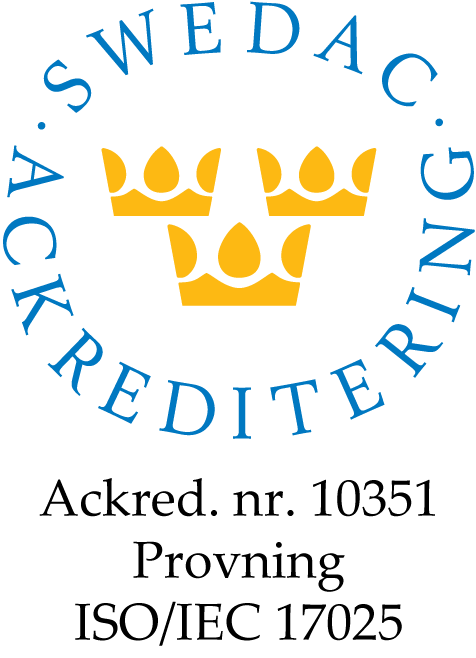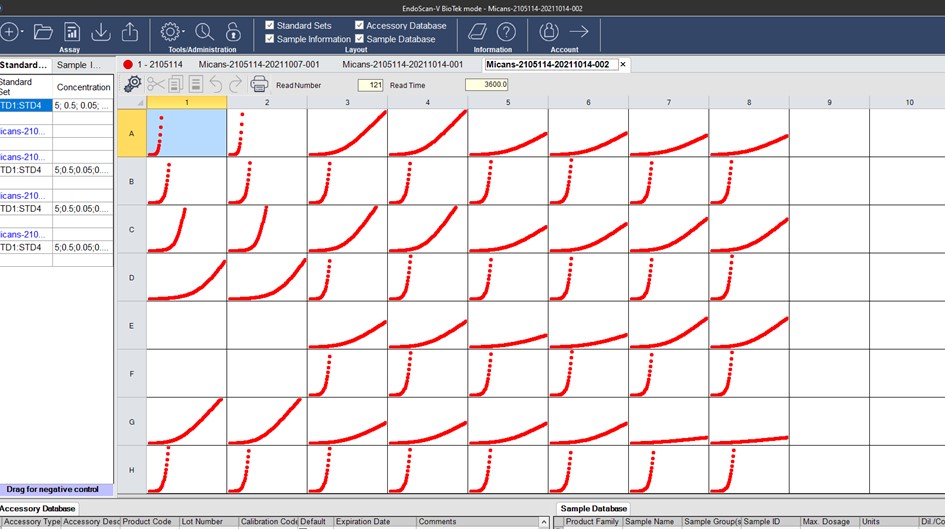Endotoxin |
 |
Micans offers ackredited endotoxin analysis. Endotoxins are toxic substances that can be released from both living and dead gram-negative bacteria and can be life-threatening at elevated levels. The assay is used, among other things, for control of endotoxin content in injection solutions, dialysis fluids, cell media, protein solutions, water, cutting fluids, etc. Even solid materials (disposable medical items, implants, etc.) can be analyzed by agreement. The assay can also be used to quantify endotoxin levels in air.
Download information sheet about the analysis here.
Method
The analysis principle is based on a coagulation system, so-called LAL (Limulus amoebocyte lysate) from the horseshoe crab (Limulus polyphemus) blood cells, which is activated by endotoxin. A kinetic chromogenic test is used for the quantitative determination of endotoxin. The analysis is performed according to the European and American pharmacopoeias Method D, Ph Eur 2.6.14 and USP-NF <85> respectively, as well as ISO 11737-3. The samples are analyzed with Charles River reagents on a BIOTEK ELx808IU plate reader EndoScan-VTM, v6 from Charles River. EndoScan is a validated software for detecting and measuring endotoxin and is used to generate quantitative LAL test data. The analysis of the instrument and subsequent data processing thus follows a strictly designed, quality-assured protocol.The method is ackredited by SWEDAC, Sweden's national accreditation body.
Costs and prices
The biggest challenge in the analysis of endotoxin lies in the varying properties of the samples because there is a lot that can affect the LAL system. An important part of this analysis is thus to know the quality and content of the samples. The analysis cost therefore depends on how much time and material must be spent on pre-processing of samples before they are placed on the analysis instrument.
For some samples, where beta-glucans may be present, we must use the Beta-Glucan Blocker. This buffer adds a certain cost to each sample. In a first step, new sample types must be analyzed broadly so that the correct pre-treatment step can be identified. Furthermore, we must validate that there are no substances that block or accelerate the LAL reaction, check that the pH of the LAL sample mixture is between 6.5 and 8 and in cases of viscous or solid samples, adapt the treatment to the correct analysis conditions. Here, the cost depends on the type of sample, we can do the validation step by step in collaboration with you to minimize the cost and optimize the result.
| Analysis | Price (excl. VAT) | |
| Analysis of endotoxin in liquids, gels, etc. including dilution steps | 1170 SEK | |
| Analysis of endotoxin in liquids, gels, etc. excluding dilution steps (direct analysis) | 1005 SEK | |
| Additional cost special preparation; weighing, two-phase separation etc. | 180 SEK | |
| Additional cost for analysis with Beta-Glucan Blocker. Samples where beta-glucan is present, which interferes with the analysis | 745 SEK |
New sample types may need to be validated before analysis. Contact us with information about your samples and we will calculate your prices and give advice on sampling and transport of the samples to the laboratory.

Screen dump from Endoscan V
Sampling and transport
It is important that all sampling steps are performed in an aseptic manner. Sterile packaged Endotoxin-free disposable tubes from unopened packaging are often sufficient. However, some plastic materials can adsorb endotoxin, which affects the test result. If there is uncertainty regarding the purity and properties of the tube, one or a few empty tubes should be sent for inspection. Micans can supply sampling materials if desired. Endotoxin-free borosilicate glass test tubes and associated lids (or bottles) are always the safest choice of test vessels. But endotoxin-free and validated plastic tubes also work well. Contact us for validation of your test vessels.
Samples must be stored in a refrigerator while waiting for transport to the laboratory. Remember: Storage at room temperature or delayed transport can give an incorrect analysis result. For example, if the samples are not sterile and contain bacteria, the endotoxin level may increase after sampling due to the growth of gram-negative bacteria in the sample. The shortest possible time between sampling and analysis is therefore always recommended.
Sample volume: The analysis requires at least 500 µL of sample if liquids are to be analyzed. If possible, we like to have at least 1000 µL in cases where we may need to rerun the assay when the sample composition challenges the assay process. This applies especially to new sample types. For solid materials, we want you to contact us first.
Order sampling material and analysis: Contact us by phone on +46 31 338 32 30 or at analys@micans.se to order sample material and analysis. It is an advantage for the laboratory's planning if you can inform us about the sample type, number of samples and estimated delivery date in advance. An order form is also sent with sample material. This must be filled in and returned together with the samples.The order form can also be downloaded here.
Samples must be sent with fast and safe transport overnight or faster to our laboratory. Note that the samples must be delivered directly to the laboratory (not to delivery points).
Microbial Analytics Sweden AB
Bruksgatan 17
SE-435 35 Mölnlycke, Sweden
If you want to analyze more than 10 samples per day, the laboratory must be contacted at least 2 days in advance. Quotation can be submitted for larger orders.
For questions, contact us on +46 31 338 32 30 or at analys@micans.se
If there is any doubt regarding the completed delivery note, e.g. if it is not possible to distinguish which sample is which or if the sample does not meet the time and temperature requirements specified in agreement with you, you will be contacted before the analysis begin.
